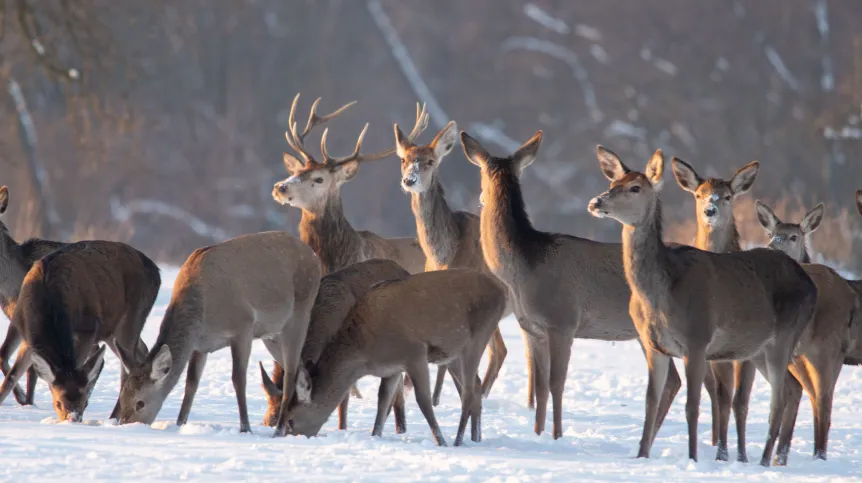
Higher activity and a more frequent nocturnal lifestyle – these were the habits of mammals during the COVID-19 pandemic lockdowns, according to a study by a team of scientists with the participation of researchers from several Polish institutions.
The results of the study were published in the prestigious journal Nature Ecology & Evolution. As the authors themselves emphasise, the scale of the project was enormous: a total of over 220 researchers participated, 163 species of wild mammals were analysed and 5,000 camera traps installed around the world. It turned out that while all wild animals felt the decreased human activity during the pandemic, they reacted to it differently. The decisive factors were where they lived and what they ate. That is why the lack of people in the environment had a very positive impact on some species and a slightly less positive impact on others.
According to the website of the University of Warsaw (scientists affiliated with this university also participated in the project), some mammals perceive humans as a threat, while for others humans are a source of protection or food. Animal habits also depends on whether they encounter humans in their natural habitats or in modified landscapes.
However, behavioural differences between different groups of animals have not been well understood until now.
SOME SPECIES LIKE TO HAVE US NEARBY
An international team of scientists with the participation of Kinga Stępniak and Dr Tom A. Diserens from the University of Warsaw, as well as specialists from the Mammal Research Institute of the Polish Academy of Sciences in Białowieża and the Institute of Environmental Sciences at the Jagiellonian University, decided to fill this gap in knowledge. To that end, they analysed material collected with camera traps. They recorded 163 mammal species living in 21 countries. The researchers compared data on the animals' habits before the pandemic and during the lockdowns to see what impact changes in human activity had on animal behaviour.
It turned out that mammal activity in more developed areas (such as cities) increased when human activity was higher. Species such as deer and raccoons would become more active around humans because they were accustomed to human presence and their food sources included rubbish.
However, animals living further from cities and other developed areas are much more sensitive to human activity and distrustful of contacts with humans. Our high activity always means a decrease in their activity.
Interestingly, the study also found that large herbivores such as deer and moose became more active when humans were nearby, while carnivores such as wolves and wolverines tended to be less active and preferred to avoid risky encounters.
'As human activity increased, large herbivore activity also increased, while carnivore activity decreased. Among omnivorous wild boars, American black bears and brown bears, activity declined in human-modified habitats. Food sources for these species include fruit trees and bins, which can be risky when human activity is high,’ says Kinga Stępniak, a doctoral candidate at the UW's Doctoral School of Exact and Natural Sciences.
The study authors also noticed that in modified landscapes where human activity was high, large predators were more likely to have a nocturnal lifestyle.
ANTHROPOPAUSE. NOT AS CLEAR AS THEY PAINT IT
In the publication summarizing their project, the scientists emphasise that the restrictions on the free movement of people related to the Covid-19 pandemic were a unique, virtually unprecedented opportunity to check how animals react when the number of people sharing their habitats changes drastically in a short time. time.
'The COVID-19 pandemic contributed to an +anthropause+, a time of reduced human activity,’ says Kinga Stępniak
Importantly, contrary to popular belief, such a period (called 'anthropause') is not a clear-cut situation at all. According to one of the authors of the study, Professor Cole Burton, 'we did not see an overall pattern of wildlife running free' while people sheltered in their homes. What caught the researchers' attention was the enormous variability in how wild mammals responded to changes in human behaviour, with the most striking trend being that the animals' responses depended on landscape conditions and their position in the food chain.
According to scientists, these findings highlight the importance of implementing prudent measures to minimise the harmful effects of human disturbance of wildlife, especially in areas with limited human infrastructure, where our presence may strongly affect animals. To provide them with the space they need, protected areas and communication corridors should be designated, or seasonal restrictions should be introduced, such as temporary closure of campsites and tourist trails during migration and breeding periods.
However, most importantly, such strategies must take into account specific locations and species.
In the summary of the publication, the authors write that in areas that are less changed and more distant from human habitats, maintaining low human activity is crucial for the protection of sensitive species. In turn, in areas where the habitats of humans and animals overlap to a greater extent, for example in cities, our presence is often beneficial to other species, although not directly. In such a situation, the night is the shelter for wild mammals. Efforts should therefore focus on reducing conflicts between people and wildlife after dark and, for example, on implementing solutions that will ensure greater safety of animals that cross busy roads.
'Context-specific knowledge on ecological responses to human actions (...) can guide locally appropriate and globally effective conservation solutions,’ the scientists say.
PAP - Science in Poland, Katarzyna Czechowicz
kap/ zan/
tr. RL













